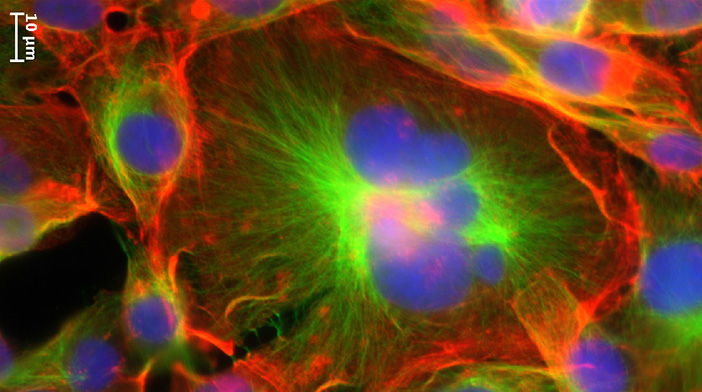First study on physical properties of polyploidal cancer cells may inform new treatments.
Polyploidal cancer cells—cells that have more than two copies of each chromosome—are much larger than most other cancer cells, are resistant to chemotherapy and radiation treatments, and are associated with disease relapse. A new study by Brown University researchers is the first to reveal key physical properties of these “giant” cancer cells.
The research, published August 9 in Scientific Reports, shows that the giant cells are stiffer and have the ability to move farther than other cancer cells, which could help explain why they’re associated with more serious disease.
“I think these polyploidal giant cancer cells are the missing link for why tumors become so complex and heterogeneous so quickly,” says Michelle Dawson, PhD, an assistant professor of molecular pharmacology, physiology, and biotechnology and the study’s corresponding author. “By understanding the physical properties of this weird population of cells, we might identify a new way to eliminate them. Patients will benefit from that.”
Dawson, who is also an assistant professor of engineering with an appointment in Brown’s Center for Biomedical Engineering, worked with Botai Xuan PhD’22 and two undergraduate students on the study, which focused on a common strain of triple negative breast cancer, which is extremely aggressive and difficult to eradicate.
They found that 2 percent to 5 percent of cells from this breast cancer strain were polyploidal cancer cells with four, eight, or 16 copies of each chromosome, instead of the normal two. The cells with more chromosomes were proportionally larger, which is similar to polyploidal cells in other organisms. (Commercially available strawberries, for example, tend to be much larger than wild strawberries because the cells of commercial varieties have eight copies of each chromosome)
After treating the breast cancer cells with a common chemotherapy, the team found three to 10 times more giant cancer cells. This both confirmed that the giant cells were more drug resistant and gave the researchers more giant cells to study.
Continue reading here.




